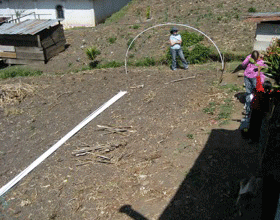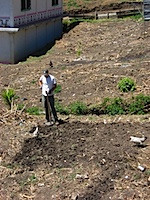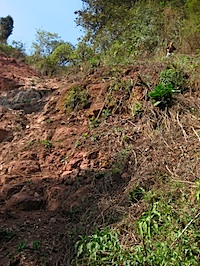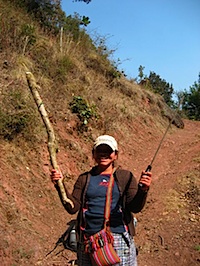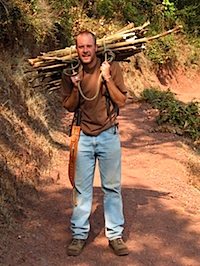 I’m a do-it-yourself kindof guy, and Emily really likes fresh food. Put these two together, and it’s time for a garden. But in this cold weather, not just ANY sort of garden will do. We need a greenhouse! So, I spoke to my dad (himself a gardener) and he decided to fund a project. For a little under $100, we built a 30′ x 12′ community experimental greenhouse. The idea with this project is that we are going to grow vegetables that don’t normally grow this far up, to show the locals that it can be done. Since we’re funding it, we take all the risk if it fails, but they reap the rewards (in educational terms) if it succeeds. We’re focusing on plants that will help round out their nutrition, giving them vitamins and minerals that they don’t get in their corn-and-beans diet: spinache, green beans, peas, tomatoes, peppers. We’re also growing a few things just for “wow”: cantaloupe, watermelon, pumpkin. Oh, and I wanted a few cucumbers, so they are in there as well.
I’m a do-it-yourself kindof guy, and Emily really likes fresh food. Put these two together, and it’s time for a garden. But in this cold weather, not just ANY sort of garden will do. We need a greenhouse! So, I spoke to my dad (himself a gardener) and he decided to fund a project. For a little under $100, we built a 30′ x 12′ community experimental greenhouse. The idea with this project is that we are going to grow vegetables that don’t normally grow this far up, to show the locals that it can be done. Since we’re funding it, we take all the risk if it fails, but they reap the rewards (in educational terms) if it succeeds. We’re focusing on plants that will help round out their nutrition, giving them vitamins and minerals that they don’t get in their corn-and-beans diet: spinache, green beans, peas, tomatoes, peppers. We’re also growing a few things just for “wow”: cantaloupe, watermelon, pumpkin. Oh, and I wanted a few cucumbers, so they are in there as well.
I mentioned my idea to Nas Palas, who owns all of the arable land around our house. He was keen on the plan, and gave us free reign to use as much space as we needed. Using a hoe, I turned up tons of black, rich soil. Then I carted six wheelbarrels full of sheep poop down to the site, and mixed that in with the dirt to make the perfect planting mix. If you click on the picture to the left, you can see the neighbors’ chickens helping me work.
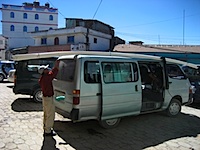
After talking to a few other Peace Corps volunteers about the cheapest way to build the greenhouse, I went to town for materials. The 1/2″ PVC tubes were easy to get, but I had to scour Santa Eulalia before I found anyone selling CLEAR nylon. Lots of black and blue (for fixing roof leaks??), but only one place with clear. And it was kindof expensive. Once we had all the goodies, we carted them through town and loaded them onto the waiting microbus. We’re buddies with most of the drivers, and they know us personally, but we got unlucky this time and the driver was the one jerky dude that always overcharges us. Aah, Guatemala. He took double fares from us and tied the goods to the roof.
The next day we went into the woods to collect wooden stakes. We spend a lot of time telling the locals it’s a bad idea to cut down all the trees, so we went to a place I know where there are still fallen timbers from a landslide last fall. We took some of our local friends with us, which turned out to be a good idea since they are pretty handy with the machete. I climbed up the cliff (that’s me, in the top right corner of the picture), cut limbs with my machete, then threw them down into the valley where Emily and the girls were waiting. Then, Elisea cut them to size with her machete. Once we had a big load of stakes, I carried them out Guate-style with a rope. Sadly, this was the hottest day we’ve had all year, and it was a fair amount of work. Time elapsed: 4 hours.
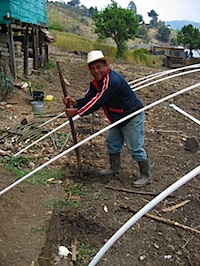 The day after that, Nas Palas came by. “Those stakes you cut will never work,” he explained. “They’re too soft, and will rot in a month. Let me get you some better ones.” He grabbed his machete and took off up the hill. Before I understood what was happening, he was back with a HUGE rick of hardwood stakes two inches in diameter. I noticed that they each had been cut through with a single swing of his machete, too. Yikes. The lesson here is that I just can’t compete with the locals in a lot if things, and that it’s always good to listen to their advice on this kind of stuff. Time elapsed: 10 minutes.
The day after that, Nas Palas came by. “Those stakes you cut will never work,” he explained. “They’re too soft, and will rot in a month. Let me get you some better ones.” He grabbed his machete and took off up the hill. Before I understood what was happening, he was back with a HUGE rick of hardwood stakes two inches in diameter. I noticed that they each had been cut through with a single swing of his machete, too. Yikes. The lesson here is that I just can’t compete with the locals in a lot if things, and that it’s always good to listen to their advice on this kind of stuff. Time elapsed: 10 minutes.
Nas then helped us put in the stakes. He had a trick method for this too, that involved a wicked-looking pole with a steel tip that you stab repeatedly into the ground until you have a posthole of sorts. I was tickled to see that the greenhouse was now becoming a community project!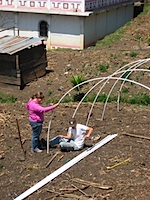 Once the stakes were in, we wired the PVC tubes to the stakes, creating giant hoops. Our friend Cat was visiting us, so she helped with that part. That’s her in the crazy pink sweater.
Once the stakes were in, we wired the PVC tubes to the stakes, creating giant hoops. Our friend Cat was visiting us, so she helped with that part. That’s her in the crazy pink sweater.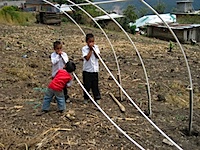 After installing the 11 hoops, we used the remaining tubes as lateral supports to stiffen the structure. That is, after the kids were done using them as trumpets. When we were about halfway through, the kids who had been watching us from the corners and rooftops couldn’t resist any longer and came over to see what the heck we were up to. Soon, they wanted to help, and got in on the act as well.
After installing the 11 hoops, we used the remaining tubes as lateral supports to stiffen the structure. That is, after the kids were done using them as trumpets. When we were about halfway through, the kids who had been watching us from the corners and rooftops couldn’t resist any longer and came over to see what the heck we were up to. Soon, they wanted to help, and got in on the act as well.
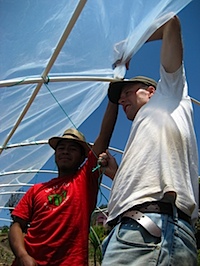 Lucas, one of our friends in town, wandered over to take a pause from his own agricultural pursuits. He helped us spread the plastic over the frame as he quizzed me about the structure: What would we plant? How much did it cost? He is one of the more forward-looking people in the village, since he spent about 5 years working in the states and has a more worldly view on how things are, and how they could be.
Lucas, one of our friends in town, wandered over to take a pause from his own agricultural pursuits. He helped us spread the plastic over the frame as he quizzed me about the structure: What would we plant? How much did it cost? He is one of the more forward-looking people in the village, since he spent about 5 years working in the states and has a more worldly view on how things are, and how they could be.
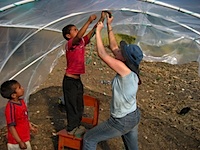
After we took a break for lunch, it was time to start sewing the covering down so it wouldn’t end up in the bottom of the valley with the first strong wind. Our buddy Chalio is ALWAYS helpful, and can be seen here helping Emily sew the nylon onto the structure. The third day, our friend and Q’anjob’al teacher Pedro came by. None of us really felt like language class, so we took it outside and worked on finishing up the greenhouse. We made ourselves feel better by practicing related words like mitx’ q’ab’ (hand 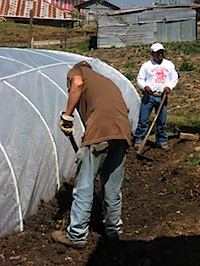 tools) and so forth. He was pretty excited about the project, as he has a similar greenhouse for growing mushrooms (except the plastic is black) and wants to do a clear one for vegetables in the near future. Pedro is just plain helpful all the time. He is also a farmer with lots of experience, and he gave us good input on what we should grow: no point in growing radishes, as they are cold-climate veggies and could just be grown outside. No point in growing a lot of cucumber, because people here aren’t interested in them. He was really enthusiastic about the watermelon and tomatoes, though, so we went heavy on those.
tools) and so forth. He was pretty excited about the project, as he has a similar greenhouse for growing mushrooms (except the plastic is black) and wants to do a clear one for vegetables in the near future. Pedro is just plain helpful all the time. He is also a farmer with lots of experience, and he gave us good input on what we should grow: no point in growing radishes, as they are cold-climate veggies and could just be grown outside. No point in growing a lot of cucumber, because people here aren’t interested in them. He was really enthusiastic about the watermelon and tomatoes, though, so we went heavy on those.
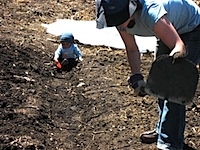 Pedro left around lunchtime, leaving us to do the finishing-up ourselves. All that remained was to hoe the mounds and rows, plant the seeds, and water it. But a last-minute helper showed up, baby Delmi, and she “helped” Emily by moving some dirt around. Eventually, Delmi’s mom showed up to reclaim her, so we let the chickens into the greenhouse instead. They were actually more helpful than Delmi, as they pounced on any grubs we turned up as we tilled. We got done just about the time the sun hit the horizon.
Pedro left around lunchtime, leaving us to do the finishing-up ourselves. All that remained was to hoe the mounds and rows, plant the seeds, and water it. But a last-minute helper showed up, baby Delmi, and she “helped” Emily by moving some dirt around. Eventually, Delmi’s mom showed up to reclaim her, so we let the chickens into the greenhouse instead. They were actually more helpful than Delmi, as they pounced on any grubs we turned up as we tilled. We got done just about the time the sun hit the horizon.
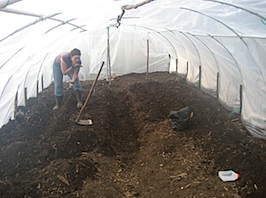 So that is how we made our greenhouse. After we finished it, I realized that it is a good project for lots of other reasons: it draws the town into being involved, and it’s VISIBLE. In our 11 months in Guatemala, it’s the first project we’ve done that has a tangible result that the people can see with their own eyes.
So that is how we made our greenhouse. After we finished it, I realized that it is a good project for lots of other reasons: it draws the town into being involved, and it’s VISIBLE. In our 11 months in Guatemala, it’s the first project we’ve done that has a tangible result that the people can see with their own eyes. 